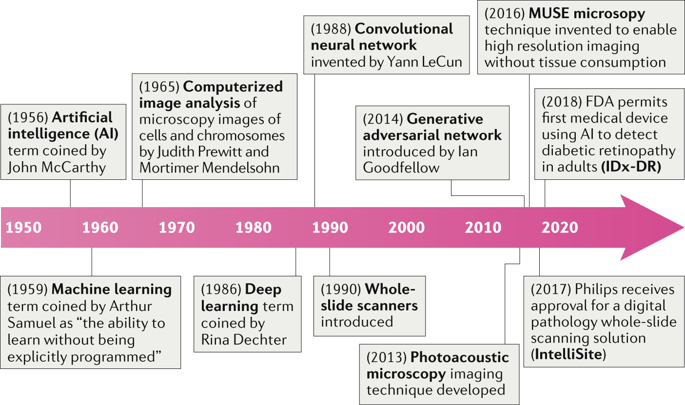Nature Reviews Clinical Oncology ( IF 78.8 ) Pub Date : 2019-08-09 , DOI: 10.1038/s41571-019-0252-y Kaustav Bera 1 , Kurt A Schalper 2 , David L Rimm 2 , Vamsidhar Velcheti 3 , Anant Madabhushi 1, 4

|
In the past decade, advances in precision oncology have resulted in an increased demand for predictive assays that enable the selection and stratification of patients for treatment. The enormous divergence of signalling and transcriptional networks mediating the crosstalk between cancer, stromal and immune cells complicates the development of functionally relevant biomarkers based on a single gene or protein. However, the result of these complex processes can be uniquely captured in the morphometric features of stained tissue specimens. The possibility of digitizing whole-slide images of tissue has led to the advent of artificial intelligence (AI) and machine learning tools in digital pathology, which enable mining of subvisual morphometric phenotypes and might, ultimately, improve patient management. In this Perspective, we critically evaluate various AI-based computational approaches for digital pathology, focusing on deep neural networks and ‘hand-crafted’ feature-based methodologies. We aim to provide a broad framework for incorporating AI and machine learning tools into clinical oncology, with an emphasis on biomarker development. We discuss some of the challenges relating to the use of AI, including the need for well-curated validation datasets, regulatory approval and fair reimbursement strategies. Finally, we present potential future opportunities for precision oncology.
中文翻译:

数字病理学中的人工智能——诊断和精准肿瘤学的新工具。
在过去的十年中,精准肿瘤学的进步导致对预测性检测的需求增加,这些检测能够选择和分层患者进行治疗。介导癌症、基质和免疫细胞之间串扰的信号传导和转录网络的巨大差异使基于单个基因或蛋白质的功能相关生物标志物的开发复杂化。然而,这些复杂过程的结果可以在染色组织标本的形态特征中得到独特的捕捉。将组织的全幻灯片图像数字化的可能性导致了数字病理学中人工智能 (AI) 和机器学习工具的出现,它们能够挖掘亚视觉形态测量表型,并可能最终改善患者管理。从这个角度来看,我们批判性地评估了各种基于人工智能的数字病理计算方法,重点关注深度神经网络和“手工制作”的基于特征的方法。我们的目标是提供一个广泛的框架,将人工智能和机器学习工具纳入临床肿瘤学,重点是生物标志物的开发。我们讨论了与使用 AI 相关的一些挑战,包括需要精心策划的验证数据集、监管批准和公平的报销策略。最后,我们提出了精准肿瘤学的潜在未来机会。重点是生物标志物的开发。我们讨论了与使用 AI 相关的一些挑战,包括需要精心策划的验证数据集、监管批准和公平的报销策略。最后,我们提出了精准肿瘤学的潜在未来机会。重点是生物标志物的开发。我们讨论了与使用 AI 相关的一些挑战,包括需要精心策划的验证数据集、监管批准和公平的报销策略。最后,我们提出了精准肿瘤学的潜在未来机会。


























 京公网安备 11010802027423号
京公网安备 11010802027423号